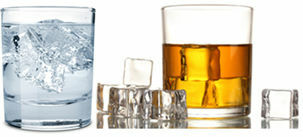Density is the relationship between the mass and volume of a material at a given pressure and temperature.
This relationship can be expressed by the formula:
d = m
V
In the SI (International System of Units), the unit of density is the kilogram per cubic meter (kg/m3). However, the most used are g/cm3 it's the g/ml, remembering that 1 cm3 equals 1 mL.
Density can be expressed for a substance or for a mixture of substances. For example, the density of water at ambient conditions is equal to 1.00 g/cm3, which means that in 1 cm3 or in 1 mL, there is 1.0 g of water.
The density of a mixture varies according to the quantities of substances involved. An example is if we prepare half a liter of a solution, mixing 50 grams of a salt in 500 g of water. The density of this solution will be given by:
d = m
v
d = 550 g → (mass of salt + mass of water)
500 ml
d = 1.1 g/ml
Density also varies with temperature. For example, when it becomes ice at a temperature below 0°C, the density of water is lower than in the liquid state, changing to 0.92 g/cm
3. This is even why ice floats on water, as it is less dense. In alcohol, on the other hand, ice sinks, as the density of ethanol is lower than that of ice (0.79 g/cm3).
Density of ice compared to water and ethanol
The concept of density is very important in everyday life. An example of this is that through it it is possible to verify if there has been any adulteration in certain products that are marketed. This happens with milk and fuel ethanol, where the most frequent adulteration is the addition of water, and also with gasoline, when more ethanol is added than allowed by the National Petroleum Agency (ANP), which is 25% by volume.
The use of a device, called a densimeter, allows checking whether the density of liquids has changed due to the addition of a different product.

The densimeter is used to measure density of liquids.
By Jennifer Fogaça
Graduated in Chemistry
Source: Brazil School - https://brasilescola.uol.com.br/o-que-e/quimica/o-que-e-densidade.htm
